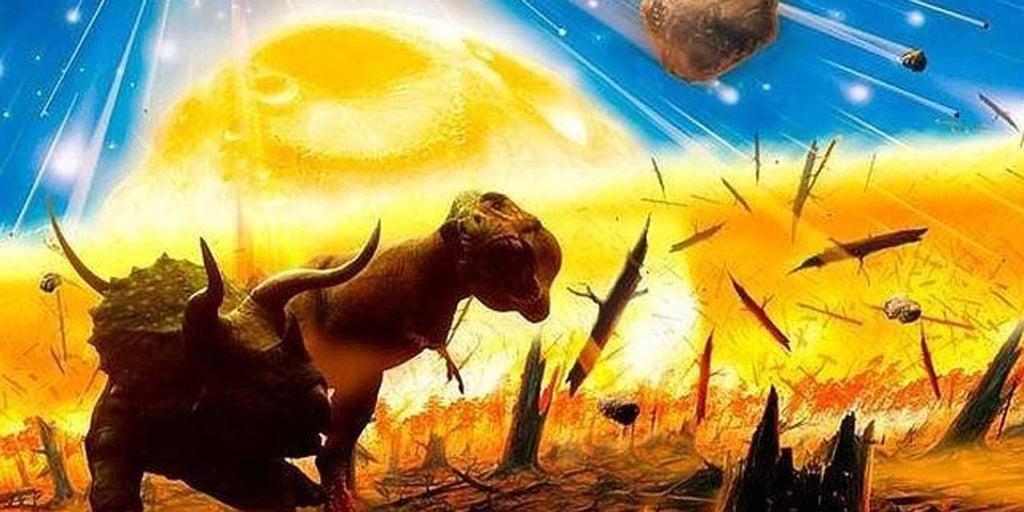A new studies extend to the impacted to the impacted that they drove to stretch, are dinosaurs no longer stagnant, but in an excellent ecological health.They were strong, diverse and thrown until a cosmic event suddenly completed their long rule.
No, the dinosaurs did not decline before the impact that killed them
New research shows that, before the impact that killed them, the dinosaurs were not dormant, but instead we were healthy all over the world.They were powerful, diverse, and thriving until a comical event abruptly ended their reign.
These were the first hours of the dinosaur extinction
This functionality is only for registered users
66 million years ago, the curtain of the Mesozoic era fell in the most violent way imaginable.The impact of an asteroid with a diameter of more than 10 kilometers on the Yucatan Peninsula effectively sealed the fate of three-quarters of life on Earth, including the dinosaurs, creatures which, for 160 million years, dominated the planet on land, sea and in the air.
However, although the main cause of death is clear, the scientific debate about the actual 'health' of the population before the cataclysm has raged.Did the dinosaurs suddenly disappear when they were still in prime condition, or did they decline long and slowly, caused by other causes and left very vulnerable to disasters?
Historically, the balance has tilted toward the latter possibility.But a new study, led by Andrew Flynn of New Mexico State University's Department of Geological Sciences and just published in the journal Science, has highlighted the final chapter in dinosaur life.When the meteorite fell, they no longer languished, but instead enjoyed better ecological health.They were alive, they were different, and they were thriving, until suddenly a world-horror event brought about their very long reign.
The missing piece of the puzzle
Until now, most of the well-dated and robust subsurface fauna that existed immediately before and after the impact, the Cretaceous-Paleogene (K-PG) boundary, has come from almost one region: the northern Great Plains of North America, primarily the known Hell Creek Formation.This site, which spans Montana, the Dakotas and Wyoming, is an unparalleled window into the study of iconic species such as Tyrannosaurus Rex or Triceratops.
But it is clear that the end of the world based on the study of a single region leads to problems.It is like trying to judge the health of an entire nation by studying only what is happening in one city.In the new study, Flynn and his colleagues fill this gap and focus on an area 1,500 kilometers south of Hell Creek: the Kirtland Formation and the 'Nashobito Member' of New Mexico.The area has already yielded fossils in the past, but their dating has always been controversial, which means that its paleontological estimates are not very reliable and have not been used to determine the state of the population before the impact.Indeed, they are probably considered older than the early or middle Maastrichtian.
Pero eso ha cambiado gracias al uso de la datación radioisotópica y la magnetoestratigrafía, técnicas que permiten fechar rocas con una precisión espectacular usando elementos como el uranio y el plomo o los cambios en el campo magnético terrestre. Avances que han permitido a Flynn y su equipo demostrar que las capas de Naashoibito se depositaron precisamente entre hace 66,4 y 66,0 millones de años, lo que significa que los dinosaurios enterrados allí vivieron al mismo tiempo que los de Hell Creek, justo en los últimos cientos de miles de años antes del impacto.
Studying the depth of reduction
The fauna of the nasoibito includes species that are very different from those of the North, which allowed scientists to establish many types of habitats in the past.And the interior is clear: below the decline, the diversity of Dinosaurs was very high and particularly divided, still divided into 'Beeroponces' (biological communities of the area).
The gradual decline hypothesis is a hypothesis that has dominated paleontology for many years.This view states that dinosaurs reached the peak of their diversity in the early period (Campanian Period, 83.6 to 72.1 million years ago) and entered a process of biological impoverishment during the Maastricht Period.The main argument is that North America no longer contains distinct regional fauna (endemics) as it did in previous periods, but has become homogeneous.
The transfer looked like this: If before the big herbivores, the climate was of a different region, and there were more species that adapted to other regions, and other species were more.According to this.In other words: the last time they were seen alive, the dinosaurs were already really "dead alive".
But new data from Naashonabito challenge this idea, confirming that dinosaurs remained isolated in the region until the end.That is, there was no poor homogeneity.The one to the south of Laramidia (new Mexico), had its 'cluster' of species, different from the one to the west (Gell Creek), and both flourished and preserved their diversity.
All this leads the researchers to a simple conclusion.If the dinosaurs slowly refused, the sin of Chicxulub was nothing more than the "last nail" in their coffin.If they are healthy, they are still lost, which means that the underground ecosystem, no matter how strong and diverse it is, cannot withstand the impact of this greatness.
Meteorites or volcanic eruptions?
The Cretaceous Paleogene (K-PG) Extinction was not the only factor affecting the demographic status of dinosaurs, but other factors may have played a role.In fact, at one point in time, it is possible that the main reason for taking science is not itself, but rather the establishment of a group of regimes in the cells of lambs in India.It's burning, 4.5 million square feet is the largest number of years in history, and it's more than a million cubic feet of corrosion and concrete movement.These processes C-Pg.A's Kursi City, of course, have significantly altered the temperature of the monument without releasing too much gas to counter the calculation.
However, modern models, especially in the local area, often show that the Tertoid is the main driver of extinction.The impact is global, an environmental disaster: large earthquakes, tsunamis, winter that is not vertical with dust and the cleanliness of the food chain is swollen.By showing the vinutaur of the dinosaurs until the last time, the new study confirms the concept of the camera and the sudden discharge caused by a meterite.
So the dinosaurs did not die from the disease, and because they could not from the public, but a sudden and fatal "cosmic pain".They were in life and life as we know it.
Why is this research important?
Such discoveries, which can improve our ideas about chapters of Earth's deep past, go far beyond the mere fascination of fossils.As the study's accompanying article in the journal Perspectives in Science points out, knowledge about the vulnerability or resilience of ecosystems in the past has direct relevance for humanity in the present moment.
Earth is plunging into what many scientists call the sixth mass extinction, this time driven by human activity.And current research on ecosystems tells us that damaged ecological networks are more susceptible to collapse.Underscoring scientists' concerns about the current loss of biodiversity.
If the gradual decline of the dinosaurs is true, then we can rest assured of one thing if we learn one lesson: the dinosaurs went extinct because they were weak.Therefore, if we keep the ecosystem healthy, we can overcome future environmental crises.
But the new reality is more disturbing.Showing that dinosaurs were healthy, diverse and well-adapted when hit by an asteroid, and yet disappeared, suggests that diversity alone is not an insurance policy against collapse.And that a sufficiently extreme event, be it a winter impact or a quick and rapid climate change, can wipe out even the strongest biological communities.
At the end of their days, then, the dinosaurs were not hideous, sickly giants, but vital and energetic creatures at the height of their diversity.But in the end it did not change the unceasing power of nature.
Session limit reached
- Access to premium content is open courtesy of the build you're building, but now many users are logged in at once.Try again after a few minutes.
You have exceeded the session limit
- You can only have three pattu starts at once.We have closed the old part so that you can continue to find a holiday without limits.
This feature is for subscribers only
This feature is for registered users only
This login function is for customers only








